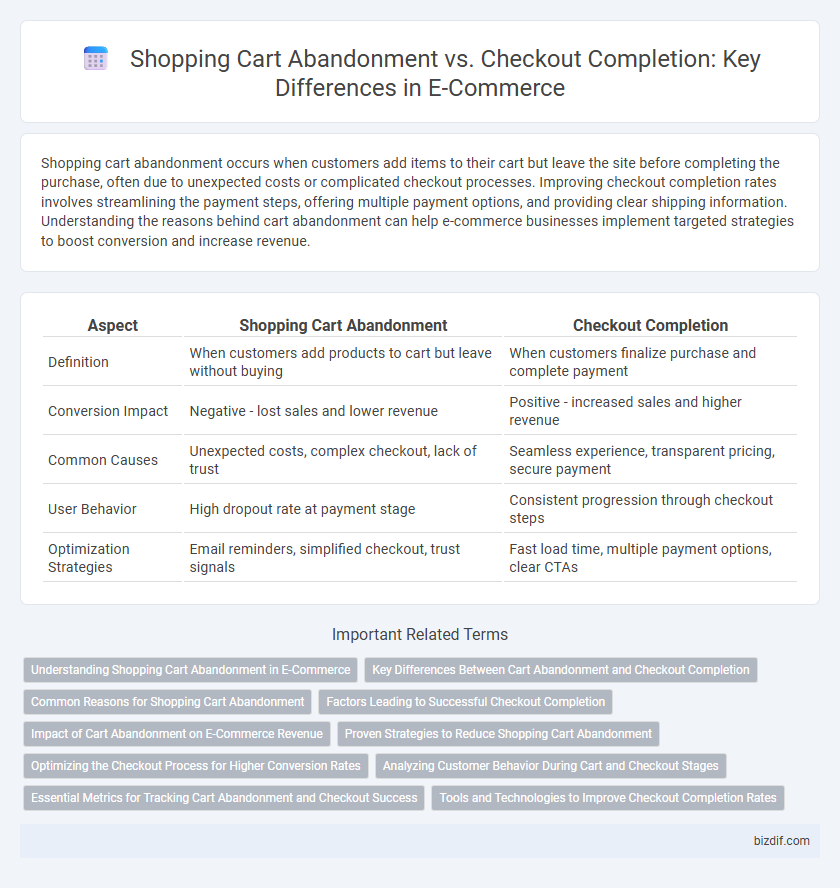Shopping cart abandonment occurs when customers add items to their cart but leave the site before completing the purchase, often due to unexpected costs or complicated checkout processes. Improving checkout completion rates involves streamlining the payment steps, offering multiple payment options, and providing clear shipping information. Understanding the reasons behind cart abandonment can help e-commerce businesses implement targeted strategies to boost conversion and increase revenue.
Table of Comparison
| Aspect | Shopping Cart Abandonment | Checkout Completion |
|---|---|---|
| Definition | When customers add products to cart but leave without buying | When customers finalize purchase and complete payment |
| Conversion Impact | Negative - lost sales and lower revenue | Positive - increased sales and higher revenue |
| Common Causes | Unexpected costs, complex checkout, lack of trust | Seamless experience, transparent pricing, secure payment |
| User Behavior | High dropout rate at payment stage | Consistent progression through checkout steps |
| Optimization Strategies | Email reminders, simplified checkout, trust signals | Fast load time, multiple payment options, clear CTAs |
Understanding Shopping Cart Abandonment in E-Commerce
Shopping cart abandonment in e-commerce occurs when customers add products to their online cart but leave the site without completing the purchase, resulting in an average abandonment rate of nearly 70%. Key factors influencing this behavior include unexpected costs, complex checkout processes, and lack of trust in payment security. Understanding these reasons helps businesses optimize user experience, streamline checkout flows, and implement targeted recovery strategies to improve checkout completion rates and increase revenue.
Key Differences Between Cart Abandonment and Checkout Completion
Shopping cart abandonment occurs when customers add products to their cart but leave the site before finalizing the purchase, leading to lost conversions for e-commerce businesses. Checkout completion, on the other hand, signifies successful transaction finalization where customers complete payment and order confirmation. Key differences include user intent, with abandonment indicating hesitation or distraction, and checkout completion demonstrating purchase commitment and effective user experience.
Common Reasons for Shopping Cart Abandonment
High shopping cart abandonment rates in e-commerce often stem from unexpected shipping costs, complicated checkout processes, and lack of payment options. Slow website performance and concerns about data security also significantly deter customers from completing purchases. Addressing these issues can enhance user experience and improve checkout completion rates, boosting overall conversion.
Factors Leading to Successful Checkout Completion
Clear and transparent pricing, multiple secure payment options, and a streamlined, user-friendly checkout process significantly increase successful checkout completion rates. Optimized website speed, mobile responsiveness, and trust signals like customer reviews and security badges reduce shopping cart abandonment by enhancing user confidence. Offering guest checkout and personalized incentives such as discounts or free shipping further encourage customers to finalize their purchases.
Impact of Cart Abandonment on E-Commerce Revenue
Shopping cart abandonment significantly reduces e-commerce revenue by causing lost sales opportunities and increasing customer acquisition costs. Studies show that the average cart abandonment rate ranges between 60% and 80%, meaning more than half of potential purchases never reach checkout completion. Improving user experience and streamlining the checkout process can directly enhance conversion rates and boost overall revenue.
Proven Strategies to Reduce Shopping Cart Abandonment
Reducing shopping cart abandonment requires targeted strategies such as simplifying the checkout process, offering multiple secure payment options, and providing clear shipping costs upfront. Implementing retargeting emails and personalized discounts can effectively recover lost sales by encouraging customers to complete their purchases. Optimizing site speed and mobile responsiveness also enhances user experience, leading to higher checkout completion rates.
Optimizing the Checkout Process for Higher Conversion Rates
Reducing shopping cart abandonment by streamlining the checkout process significantly improves conversion rates in e-commerce platforms. Implementing one-click payment options, minimizing form fields, and providing transparent shipping costs enhance user experience and encourage transaction completion. Data shows that optimizing checkout usability can increase conversion rates by up to 35%, highlighting its critical role in maximizing revenue.
Analyzing Customer Behavior During Cart and Checkout Stages
Shopping cart abandonment occurs when customers add items to their cart but leave before completing the purchase, often influenced by unexpected costs, complicated checkout processes, or lack of trust signals. Analyzing customer behavior during the cart and checkout stages reveals critical drop-off points, such as form friction or payment method limitations, which directly impact conversion rates. Optimizing the checkout experience through simplified navigation, transparent pricing, and multiple payment options increases the likelihood of checkout completion and reduces cart abandonment rates.
Essential Metrics for Tracking Cart Abandonment and Checkout Success
Tracking the shopping cart abandonment rate and checkout completion rate is essential for optimizing e-commerce sales funnels. Key metrics include cart abandonment rate, average cart value, checkout conversion rate, and time spent in checkout process, providing insights into customer behavior and potential friction points. Analyzing these metrics enables targeted improvements in user experience, payment options, and cart recovery strategies to increase revenue.
Tools and Technologies to Improve Checkout Completion Rates
Advanced tools like cart recovery emails, push notifications, and AI-powered personalized recommendations significantly reduce shopping cart abandonment by re-engaging potential buyers. Integrating seamless payment gateways and one-click checkout technology accelerates the buying process, enhancing checkout completion rates. Data analytics and customer behavior tracking software enable retailers to identify friction points and optimize the checkout experience for maximum conversion.
Shopping Cart Abandonment vs Checkout Completion Infographic

 bizdif.com
bizdif.com